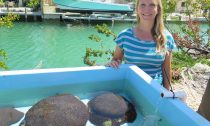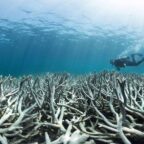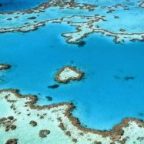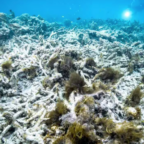
At Mote Marine Lab’s Center for Coral Reef Research and Restoration in the Florida Keys, Joey Mandara is like a baby sitter. But instead of children he tends to thousands of baby corals, growing in large, shallow tanks called raceways. Mote has been doing this work for five years, raising corals from embryos into adult colonies, then planting them on Florida’s reefs. Now, the emergence of a new, debilitating coral disease makes his work more important than ever.
In one raceway, Mandara says fragments of brain coral have grown quickly in this controlled environment.
“The brain coral were eight fragments,” he says. “And over time, they’ve grown out and have now fused into each other, becoming one coral that will hopefully over time become sexually mature.”
Mote lab’s science director Erinn Muller calls such progress “our beacon of hope.”
Around the world, coral reefs are facing trouble. Coral bleaching, due in part to rising ocean temperatures, has stressed reefs, leaving them weakened and susceptible to disease. Now, in Florida, scientists are struggling to combat a mysterious disease that’s threatening the future of the world’s third largest coral reef.
In just four years, the so-far unidentified disease has already had a dramatic impact on Florida’s reef tract, which extends some 360 miles down the state’s Atlantic coast. Muller says it appears to be a bacterial disease, and for about half of the state’s species of coral it’s deadly.
“When they’re affected by this, the tissue sloughs off the skeleton,” she says. “And we see that once a coral is infected, it usually kills the entire coral, sometimes within weeks. And it doesn’t seem to stop.”
A ‘local extinction’ that’s on the move
William Precht was one of the first scientists to spot the outbreak and the impact it was having on corals. In 2014, he was hired by the state to monitor the health of reefs off the port of Miami, where a dredging project was underway. He saw the disease move from one patch of coral to another.
Precht says it’s proved especially deadly for species of brain and star coral, which form the foundation for many reefs. In some areas now, he says almost all of those corals are dead.
“This is essentially equivalent to a local extinction, an ecological extirpation of these species locally,” he says. “And when you go out and swim on the reefs of Miami-Dade County today, it would be a very rare chance encounter that you’d see some of these three or four species.”
Scientists believe ocean currents help spread the disease. Since it was first discovered, it’s moved north, affecting reefs all the way up to the St. Lucie inlet. It’s now moving south, through the Florida Keys.
A large number of researchers are working to tackle the disease on many fronts. Some are using DNA analysis to try to identify the pathogens involved. Muller of Mote Marine says others are looking for ways to stop the disease from spreading.
“Anything from… looking at chlorine-laced epoxy as an antiseptic, and even looking at how antibiotics interact with the disease,” she says. “Because if it is bacterial, then antibiotics would be a way to stop it.”
This disease outbreak is the latest blow to a reef system that has been stressed and battered by decades of development, poor water quality and rising sea temperatures. After a long decline in Florida, coral reefs have been decimated, leaving too few species to successfully reproduce and rebuild the population on their own.
That’s why Muller believes the best hope now is to raise healthy corals in the lab and transplant them onto reefs. “We’re really at a critical juncture right now, where we have corals left on the reef,” she says. “Before we lose more corals, now is the time to start making a change.”
Mote Marine Lab hopes to plant 35,000 of its lab-raised corals onto reefs in the Keys this year. Muller says so far, corals raised in the lab have shown resistance to the mystery disease, giving scientists hope they may yet be able to save Florida’s reefs.















Social Profiles